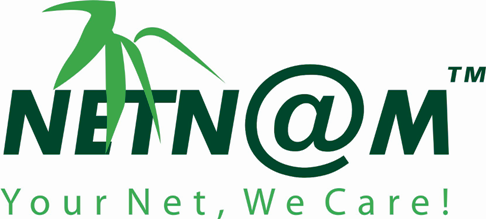Về nền tảng M$.
Đây là phần chú Biu M$
-
http://www.facebook.com/microsoftdeveloper
-
https://twitter.com/msdev
-
http://plus.google.com/111221966647232053570/
Only Microsoft brings you a complete set of innovative
platforms and technologies that help you shape the future. Whether you develop
for mobile, desktop, or the cloud–you are always playing in a single universe
of devices and services. It’s time to go exploring.
Chỉ M$ mới mang đến cho bạn một bộ hoàn chỉnh các nền tảng sáng tạo và công nghệ, giúp bạn định hình tương lai. Cho dù bạn phát triển phần mềm cho điện thoại di động, máy tính để bàn, hoặc điện toán đám mây – bạn luôn được chơi trong một thế giới các thiết bị và dịch vụ thống nhất. Hãy để chút thời gian khám phá…
(Chú Biu gáy to ghê)
Featured platforms and tools

Windows
Reach more people on more devices in 200 markets worldwide.
Visit the Dev Center
Discover the fastest-growing mobile OS on the market.
Need a cloud-based backend for your app? We’ve got you covered.
Develop productivity apps in their native environment—locally or in the cloud.

Xbox
Imagine your game on more than 76 million consoles worldwide.
Visit the Dev Center
Create a new breed of applications with these powerful tools.
Cloud and server
Discover the power and scalability of a Cloud OS.
Turning big data into big insights begins here.
From backup to backend, cloud database applications are changing business.
Extend your existing apps and connect cloud applications, mobile devices, and
external partners.
Business and enterprise
Apps that revolutionize work on the most popular collaboration platform in the
world.
146 billion e-mails are sent per day. How will you enable better communications?
Tomorrow’s workplace is anywhere you are. Add your vision to the future.
Resource planning is essential to companies and organizations. The only thing
missing is your idea.
More resources
Take a step:

Success stories
See how easy it is to develop with Microsoft—and how it pays off.
Watch now
Connect with tech advisors. Get some perspective. Attend an event.
Kick off your project with Microsoft’s development tools.
Ready to turn your game idea into reality?
Learning resources
Community
Support
Programs
ADM and the Zachman Framework
Introduction | The Zachman Framework | Mapping TOGAF to the Zachman Framework
This chapter provides a mapping of the TOGAF Architecture Development Method (ADM) to the Zachman Framework.
Introduction
A number of architecture frameworks exist, each of which has its particular advantages and disadvantages, and relevance, for enterprise architecture. Several are discussed in Other Architectures and Frameworks .
However, there is no accepted industry standard method for developing an enterprise architecture. The Open Group goal with TOGAF is to work towards making the TOGAF ADM just such an industry standard method, which can be used for developing the products associated with any recognized enterprise framework that the architect feels is appropriate for a particular architecture. The Open Group vision for TOGAF is as a vehicle and repository for practical, experience-based information on how to go about the process of enterprise architecture, providing a generic method with which specific sets of deliverables, specific reference models, and other relevant architectural assets can be integrated.
To illustrate the concept, this section provides a mapping of the various phases of the TOGAF ADM to the cells of the well-known Zachman Framework.
The Zachman Framework
The Zachman Framework for Enterprise Architecture, sometimes simply referred to as the “Zachman Framework”, has become a de facto standard for classifying the artifacts developed in enterprise architecture. It is a logical structure for classifying and organizing the design artifacts of an enterprise that are significant to its management. It draws on a classification scheme found in the more mature disciplines of architecture/construction and engineering/manufacturing, used for classifying and organizing the design artefacts relating to complex physical products such as a building or an aircraft. Zachman adopts this classification scheme to the design and construction of information systems.
The Zachman Framework comprises a 6×6 matrix.
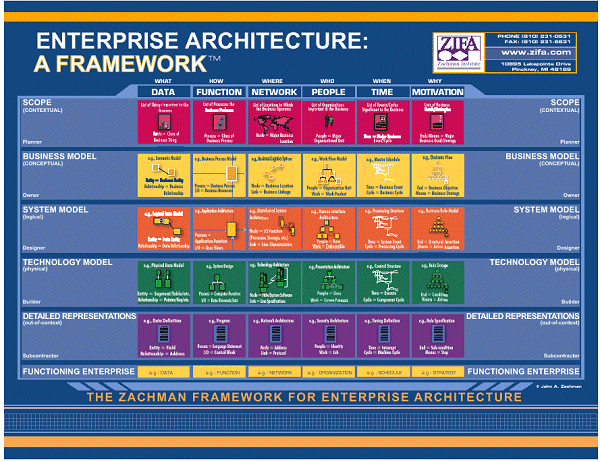
The columns represent various aspects of the enterprise that can be described or modeled; and the rows represent various viewpoints from which the aspects can be described. Thus each cell formed by the intersection of a column and a row represents an aspect of the enterprise modeled from a particular viewpoint. The architect selects and models the cells that are appropriate to the immediate purpose, with the ultimate objective of modeling all the cells.
The six viewpoints are:
- The Scope (Contextual) viewpoint – aimed at the planner
- The Business Model (Conceptual) viewpoint – aimed at the owner
- The System (Logical) viewpoint – aimed at the designer
- The Technology (Physical) viewpoint – aimed at the builder
- The Detailed Representations (Out-of-Context) viewpoint – aimed at the subcontractor
- The Functioning Enterprise viewpoint
The six aspects – and the interrogatives to which they correspond – are:
- The Data aspect – What?
- The Function aspect – How?
- The Network aspect – Where?
- The People aspect – Who?
- The Time aspect – When?
- The Motivation aspect – Why?
Although the Zachman Framework applies to enterprises, the Framework itself is generic. It is a comprehensive, logical structure for the descriptive representations (i.e., models or design artefacts) of any complex object, and it does not prescribe or describe any particular method, representation technique, or automated tool.
The strength of the Framework is that it provides a way of thinking about an enterprise in an organized way, so that it can be described and analyzed. It also enables the individuals involved in producing enterprise information systems to focus on selected aspects of the system without losing sight of the overall enterprise context. In designing and building complex systems, such as enterprise systems, there are simply too many details and relationships to consider simultaneously. At the same time, isolating single variables and making design decisions out of context results in sub-optimization, with all the attendant costs and risks. The challenge is the same whether the system is physical (like an aircraft) or conceptual (like an enterprise system). How do you design and build it, piece by piece, and step by step, such that it achieves its purpose without losing its value and raising its cost by optimizing the pieces and sub-optimizing the overall?
Mapping TOGAF to the Zachman Framework
The scope of the four architecture domains of TOGAF align very well with the first four rows of the Zachman Framework, as shown in the following mapping of these domains.
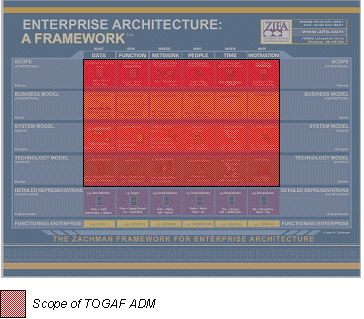
Several domains overlap in the above diagram: the earliest domain to address a cell has precedence in the coloring scheme.
The mappings of the individual phases of the ADM are shown in detail below.
- Note:
- In addition to the mappings to specific cells given below, the detailed representations and functioning enterprise viewpoints (the lowest two rows) of the Zachman Framework are also addressed and represented in TOGAF, through the Architecture Governance Framework (see Architecture Governance Framework), and through ADM deliverables such as the various Architecture Contracts (see Architecture Contracts). These ensure the validity and viability of the delivered solutions to meet the business needs.
Preliminary Phase: Framework and Principles
The outputs of this phase are:
- Framework DefinitionZF: Business/Function (model of the architecture development process)
[R2,C2] - Architecture principlesZF: Scope/Data, Scope/Function, Scope/Network, Scope/People, Scope/Time, Scope/Motivation
[R1,C1; R1,C2; R1,C3; R1,C4; R1,C5; R1,C6] - Restatement of, or reference to, business principles, business goals, and business driversZF: Composite of: Scope/Motivation, Business/Motivation
[R1,C6; R2,C6]
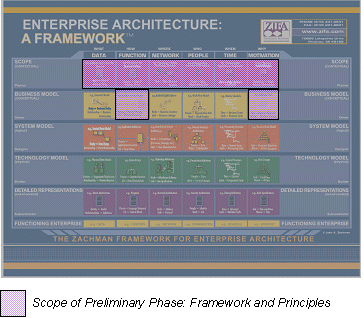
Phase A: Architecture Vision
The outputs of this phase are:
- Approved Statement of Architecture Work, including in particular:
- Scope and constraintsZF: Scope/Data, Scope/Function, Scope/Network, Scope/People, Scope/Time
[R1,C1; R1,C2; R1,C3; R1,C4; R1,C5; R1,C6]- Note:
- The Scope/Motivation cell is presumed to be addressed by strategic business planning activities outside the scope of the Architecture Vision.
- Plan for the architecture work
- Scope and constraintsZF: Scope/Data, Scope/Function, Scope/Network, Scope/People, Scope/Time
- Refined statements of business principles, business goals, and strategic driversZF: Scope/Data, Scope/Motivation
[R1,C1; R1,C6] - Architecture principles (if not previously existing)ZF: Scope/Data, Scope/Function, Scope/Network, Scope/People, Scope/Time, Scope/Motivation
[R1,C1; R1,C2; R1,C3; R1,C4; R1,C5; R1,C6] - Architecture Vision/Business Scenario, including:
- Baseline Business Architecture, Version 0.1ZF: Business/Data, Business/Function, Business/Network, Business/People, Business/Time, Business/Motivation
[R2,C2; R2,C2; R2,C3; R2,C4; R2,C5; R2,C6] - Baseline Technology Architecture, Version 0.1ZF: System/Data, System/Function, System/Network, System/People, System/Time, System/Motivation
[R3,C2; R3,C2; R3,C3; R3,C4; R3,C5; R3,C6] - Target Business Architecture, Version 0.1ZF: Business/Data, Business/Function, Business/Network, Business/People, Business/Time, Business/Motivation
[R2,C2; R2,C2; R2,C3; R2,C4; R2,C5; R2,C6] - Target Technology Architecture, Version 0.1ZF: System/Data, System/Function, System/Network, System/People, System/Time, System/Motivation
[R3,C2; R3,C2; R3,C3; R3,C4; R3,C5; R3,C6]
- Baseline Business Architecture, Version 0.1ZF: Business/Data, Business/Function, Business/Network, Business/People, Business/Time, Business/Motivation
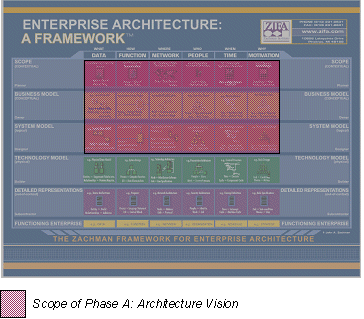
Phase B: Business Architecture
The outputs of this phase are:
- Statement of Architecture Work (updated if necessary)
- Validated business principles, business goals, and strategic driversZF: Scope/Data, Scope/Function, Scope/Network, Scope/People, Scope/Time
[R1,C1; R1,C2; R1,C3; R1,C4; R1,C5; R1,C6] - Target Business Architecture, Version 1.0 (detailed)
- Organization structure, identifying business locations and relating them to organizational unitsZF: Scope/Network, Scope/People, Business/Network, Business/People
[R1,C3; R1,C4; R2,C3; R2,C4] - Business goals and objectives, for each organizational unitZF: Scope/Network, Scope/Time, Business/Network, Business/Time, Business/Motivation
[R1,C3; R1,C5; R2,C3; R2,C5; R2,C6]- Note:
- The Scope/Motivation cell is presumed to be addressed by strategic business planning activities outside the scope of the Business Architecture.
- Business functions – a detailed, recursive step involving successive decomposition of major functional areas into sub-functionsZF: Scope/Function, Business/Function
[R1,C2; R2,C2] - Business services – the services that each enterprise unit provides to its customers, both internally and externallyZF: Business/Function, System/Function
[R2,C2; R3,C2] - Business processes, including measures and deliverablesZF: Business/Function, Business/Time
[R2,C2; R2,C5] - Business roles, including development and modification of skills requirementsZF: Scope/People, Business/People
[R1,C4; R2,C4] - Correlation of organization and functions; relate business functions to organizational units in the form of a matrix reportZF: Scope/Function, Scope/Network, Scope/People, Business/Function, Business/Network, Business/People
[R1,C2; R1,C3; R1,C4; R2,C2; R2,C3; R2,C4]
- Organization structure, identifying business locations and relating them to organizational unitsZF: Scope/Network, Scope/People, Business/Network, Business/People
- Baseline Business Architecture, Version 1.0 (detailed), if appropriate
- Views corresponding to the selected viewpoints addressing key stakeholder concerns
- Gap analysis results
- Technical requirements (drivers for the Technology Architecture work): identifying, categorizing, and prioritizing the implications for work in the remaining architecture domains; for example, by a dependency/priority matrix (e.g., guiding trade-off between speed of transaction processing and security); list the specific models that are expected to be produced (e.g., expressed as primitives of the Zachman Framework)ZF: System/Motivation
[R3,C6] - Business Architecture Report
- Updated business requirements
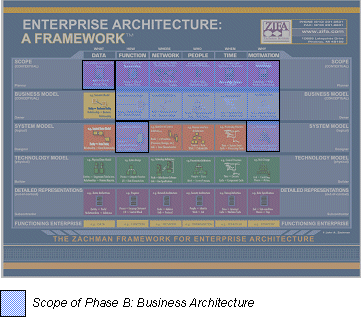
- Note:
- The Business/Data cell is covered by the Data and Applications Architectures.
Phase C: Informations System Architectures: Data Architecture
The outputs of this part of Phase C are:
- Statement of Architecture Work (updated if necessary)
- Baseline Data Architecture, Version 1.0, if appropriate
- Validated principles, or new data principles (if generated here)ZF: Scope/Data, Scope/Network, Scope/People, Scope/Time
[R1,C3; R1,C4; R1,C5] - Target Data Architecture, Version 1.0:
- Business data modelZF: Business/Data
[R2,C1] - Logical data modelZF: System/Data
[R3,C1] - Data management process modelsZF: System/Function, System/People
[R3,C2; R3,C3] - Data entity/business function matrixZF: Composite of Business/People, System/Data, System/Function
[R2,C4; R3,C1; R3,C2] - Data interoperability requirementsZF: Composite of System/Data, System/Function, System/Network, System/People
[R3,C1; R3,C2; R3,C3; R3,C4]
- Business data modelZF: Business/Data
- Viewpoints addressing key stakeholder concerns
- Views corresponding to the selected viewpoints; for example:
- Data dissemination viewZF: Composite of System/Data, System/Function, System/Network, System/People
[R3,C1; R3,C2; R3,C3; R3,C4] - Data lifecycle viewZF: Composite of System/Data, System/Function, System/Time
- Data security viewZF: Composite of System/Function, System/Data, System/Network, System/People, System/Time
- Data model management viewZF: Composite of Business/Data, System/Data, Business/Time, System/Time
- Data dissemination viewZF: Composite of System/Data, System/Function, System/Network, System/People
- Gap analysis results
- Relevant technical requirements that will apply to this evolution of the architecture development cycleZF: System/Motivation
- Data Architecture Report, summarizing what was done and the key findings
- Impact Analysis
- Updated business requirements, if appropriate
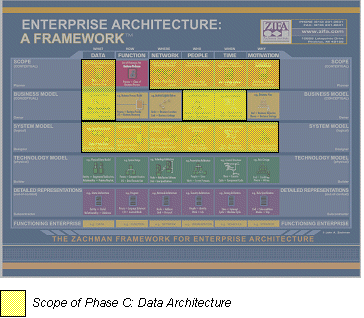
Phase C: Informations System Architectures: Applications Architecture
The outputs of this part of Phase C are:
- Statement of Architecture Work (updated if necessary)
- Baseline Applications Architecture, Version 1.0, if appropriate
- Validated application principles, or new application principles (if generated here)ZF: Scope/Function, Scope/Network, Scope/People, Scope/Time
- Target Applications Architecture, Version 1.0:
- Process systems modelZF: System/Function
- Systems/place modelZF: System/Network
- People/systems modelZF: System/People
- Systems/time modelZF: System/Time
- Applications interoperability requirementsZF: Composite of System/Data, System/Function, System/Network, System/People, System/Time, System/Motivation
- Viewpoints addressing key stakeholder concerns
- Views corresponding to the selected viewpoints; for example:
- Common applications services viewZF: Composite of System/Data, System/Function, System/Network, System/People, System/Time
- Applications interoperability viewZF: Composite of System/Data, System/Function, System/Network, System/Time
- Applications/information viewZF: Composite of System/Data, System/Function, System/Network, System/Time
- Applications/user locations viewZF: Composite of System/Network, System/People
- Gap analysis results
- Areas where the Business Architecture may need to change to cater for changes in the Applications ArchitectureZF: Composite of Business/Data, Business/Function, Business/Network, Business/People, Business/Time
- Identify any areas where the Data Architecture (if generated at this point) may need to change to cater for changes in the Applications ArchitectureZF: Composite of Business/Data, Business/People, Business/Time
- Identify any constraints on the Technology Architecture about to be designedZF: System/Motivation
- Applications Architecture Report, summarizing what was done and the key findings
- Impact Analysis
- Updated business requirements, if appropriate
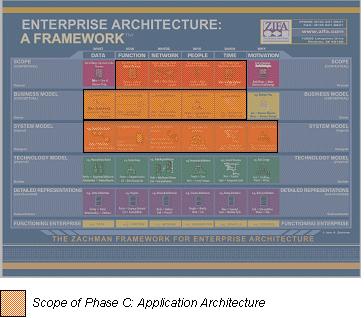
Phase D: Technology Architecture
The outputs of Phase D are given below, first by relevant individual step, and then as a composite for the whole phase.
Step 1: Create a Baseline Description in the TOGAF Format
The outputs of this step are:
- Technology Architecture principles (if not existing)ZF: Scope/Data, Scope/Function, Scope/Network, Scope/People, Scope/Time, Scope/Motivation
- Target Technology Architecture, Version 0.2:
- Technology Architecture – Constraints
- Technology Architecture – Architecture Principles
- Technology Architecture – Requirements Traceability, key questions list
- Technology Architecture – Requirements Traceability, criteria for selection of service portfolio
- Technology Architecture Model, Version 0.1ZF: Technology/Function, Technology/Network
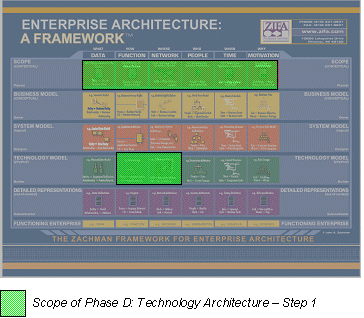
Step 2: Consider Different Architecture Reference Models, Viewpoints, and Tools
The outputs of this step are:
- Target Technology Architecture, Version 0.3
- Technology Architecture – Architecture Viewpoints
- Networked computing/hardware viewZF: System/Network, Technology/Network
- Communications viewZF: Composite of: System/Network, System/People, Technology/Network, Technology/People
- Processing viewZF: System/Data, System/Function, System/Network, System/People, System/Time, Technology/Data, Technology/Function, Technology/Network, Technology/People, Technology/Time
- Cost viewZF: Technology/Motivation
- Standards viewZF: Technology/Motivation
- Technology Architecture – ConstraintsZF: System/Motivation
- Technology Architecture – Architecture Viewpoints
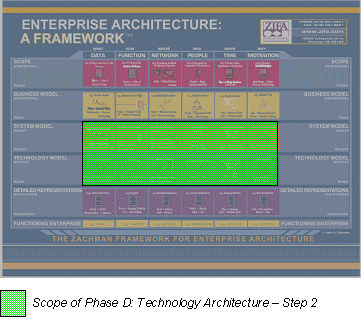
Step 3: Create an Architectural Model of Building Blocks
The outputs of this step are:
- Target Technology Architecture, Version 0.4
- Technology Architecture Model
- Networked computing/hardware viewZF: Technology/Network, System/Network
- Communications viewZF: Composite of: Technology/Network, Technology/People, System/Network, System/People
- Processing viewZF: Technology/Network, Technology/Time, Technology/People, Technology/Data, Technology/Function, System/Network, System/Time, System/People, System/Data, System/Function
- Cost viewZF: Technology/Motivation
- Standards viewZF: Technology/Motivation
- Technology Architecture – change requests and/or extensions or amendments to be incorporated in an organization-specific Architecture Continuum
- Technology Architecture Model
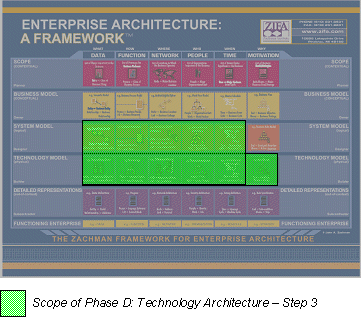
Step 4: Select the Services Portfolio Required per Building Block
The outputs of this step are:
- Target Technology Architecture, Version 0.5
- Technology Architecture – target services (a description of the service portfolios required also known as an Organization-Specific Framework)ZF: Technology/Network, Technology/Time, Technology/People, Technology/Data, Technology/Function, Technology/Motivation
- Technology Architecture – change requests and/or extensions or amendments to be incorporated in an organization-specific Architecture Continuum
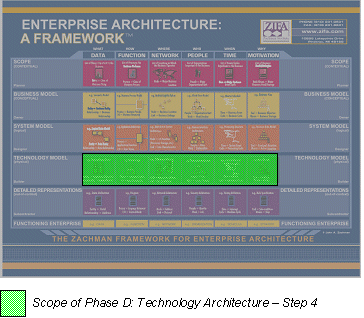
Step 8: Conduct a Gap Analysis
The outputs of this step are:
- Target Technology Architecture, Version 1.0:
- Technology Architecture – gap reportZF: Composite of Technology/Data, Technology/ Function, Technology/Network, Technology/People, Technology/Time, Technology/Motivation
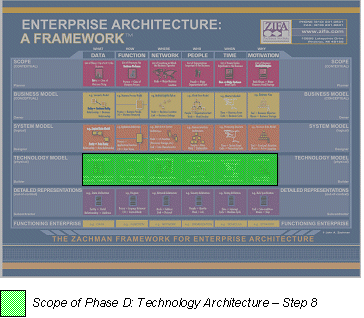
Composite Mapping for Phase D
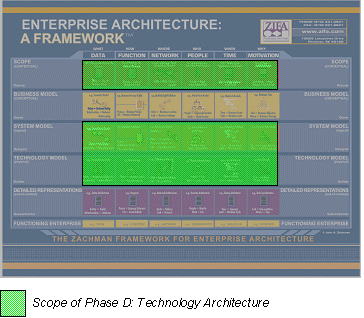
For more detailed information on the Zachman Framework, refer to any of John Zachman’s publications, or the Zachman Institute for Framework Advancement (ZIFA) (www.zifa.com).
return to top of page
The TOGAF document set is designed for use with frames. To navigate around the document:
- In the main Contents frame at the top of the page, click the relevant hyperlink (Part I, Part II, etc.) to load the Contents List for that Part of the TOGAF document into the Secondary Index frame in the left margin.
- Then click in that Contents List to load a page into this main frame.
Downloads
Downloads of the TOGAF documentation, are available under license from the TOGAF information web site. The license is free to any organization wishing to use TOGAF entirely for internal purposes (for example, to develop an information system architecture for use within that organization). A hardcopy book is also available from The Open Group Bookstore as document G063.
Những thông điệp từ quá khứ
(TTH) – Sắc phong là một nhóm tài liệu có giá trị trong hệ thống các loại văn bản Hán – Nôm của làng xã và họ tộc, đó là một loại hiện vật gốc đặc biệt quý hiếm (nói theo ngôn ngữ bảo tàng học), là tư liệu địa chí quý hiếm (nói theo ngôn ngữ thư viện học), là một loại cổ vật đặc biệt do có tính chất độc bản và là một nguồn tư liệu có giá trị về nhiều phương diện. Ngoài một số sắc phong làm chất liệu vải – lụa, chủ yếu là chất liệu giấy – giấy sắc, giấy long đằng.
Từ năm 2009 đến 2013, Thư viện Tổng hợp tỉnh phối hợp với Thư viện KHTH thành phố Hồ Chí Minh sưu tầm, số hóa được gần 105 ngàn trang tài liệu Hán – Nôm tại 26 làng với 116 dòng họ và gia đình, 12 phủ, trong đó có hàng ngàn sắc phong, chế.
Một nghề truyền thống
Theo một số tài liệu, thư tịch, nghề làm giấy sắc phong – giấy long đằng xuất hiện từ thời chúa Trịnh Tráng cách đây khoảng hơn 300 năm, là nghề độc quyền của họ Lại làng Nghè, tổng Bưởi, phủ Hoài Đức, Hà Tây (nay là phường Nghĩa Đô, Cầu Giấy, Hà Nội). Hàng năm, họ Lại cung cấp cho triều đình khoảng 2.000 tờ giấy sắc vàng, dùng làm sắc phong ban cho bách quan, bách thần đất Việt.
 |
|
Sắc phong được lưu giữ tại một tư gia |
Theo các cụ tổ của dòng họ Lại Nghĩa Đô, dưới các triều đại nhà Nguyễn, triều vua Khải Định sử dụng giấy sắc nhiều nhất, tính riêng năm tổ chức “Tứ tuần đại khánh” đã sử dụng đến 10.000 tờ. Có thể mẻ giấy sắc vàng làng nghề cuối cùng được sản xuất vào giữa năm 1944, và nghề làm giấy sắc làng Nghè cũng gần như thất truyền từ đó. Để sản xuất một tờ giấy sắc vàng là một công việc khó nhọc, trăn trở với sự lao động cần cù đầy sáng tạo của những nghệ nhân.
Nguyên liệu chính làm giấy sắc phải chọn lựa cây dó mọc ở hai bờ sông Thao (Phú Thọ) gọi là dó Thao và trải qua nhiều công đoạn như: ngâm nước lạnh và nước vôi, sau đó cho vào vạc nấu chín bằng hơi, ngoài một số công đoạn thông thường, giấy sắc còn phải thêm một số kỹ thuật khác như bóc uốn, nghè bồi keo, nhuộm vàng, vẽ hoa văn… Ngoài mặt kỹ thuật cầu kỳ độc đáo, loại giấy này còn rất đẹp. Hai mặt của đạo sắc với những nét vẽ có vàng, bạc tô điểm óng ánh lúc mềm mại, khi bay bổng. Khâu vẽ thể hiện sự tinh sảo của nghề. Người giỏi – thợ chính thì vẽ “chạy”, thợ kém hơn hay mới học việc thì vẽ “đồ” (tức theo nét “chạy” mà tô kim nhũ, vàng bạc). Nguyên liệu dùng để vẽ lên mặt giấy là các nguyên liệu hiếm quý: vàng, bạc nguyên chất và kim nhũ. Giấy sắc vì thế rất quý hiếm, hình thức màu sắc lại đẹp, không phai. Vì vậy, còn được gọi là giấy Kim Tiên. Nghệ nhân làm giấy sắc luôn giữ bí quyết kỹ thuật “đánh vàng, đánh bạc” tạo màu vẽ. Để làm công việc này họ thường làm ở những nơi kín đáo nhất trong nhà (gầm bàn thờ), nhằm tránh người ngoài học lỏm. Vì vậy, một tờ giấy sắc vàng sau khi hoàn thành có giá 1 lượng vàng dưới các triều đại nhà Nguyễn.
Lịch sử, văn hóa
Sắc phong có tên gọi đầy đủ là đạo sắc phong, bao gồm sắc phong chức tước cho quý tộc, quan chức của các vương triều và sắc phong thần do nhà vua phong tặng cho các vị thần được thờ ở trong đình, đền, miếu, từ đường…
Sắc phong trước tiên là một văn bản hành chính của nhà nước phong kiến, đứng đầu đại diện là nhà vua, ban thưởng khen ngợi cho những nhân vật có những đóng góp cho làng xã, đất nước. Những nhân vật được ban tặng sắc phong có thể là nhân thần (những người khi còn sống đã có công trạng, được làng xã thờ tự, suy tôn như thần) hoặc thiên thần, thiên nhiên thần được làng xã thờ vọng. Sắc phong truyền tải cho các thế hệ sau thông tin tư liệu trung thực về tên, tuổi, công trạng của một số nhân vật lịch sử như: quê quán, công tích. Mặt khác, sắc phong còn chứa đựng một số thông tin có thể bổ sung thêm những thiếu sót, sai lệch về lịch sử làng, xã và là một nguồn tư liệu quan trọng để nghiên cứu các tín ngưỡng dân gian. Qua sắc phong, người ta có thể biết thêm những thông tin về hệ thống hành chính với những địa danh và đơn vị hành chính mang niên đại cụ thể. Niên đại trên văn bản sắc phong Thừa Thiên Huế có vai trò quan trọng trong việc xác định mốc thời gian của việc ban cấp sắc phong, đồng thời thông qua niên đại có thể biết được những sự kiện lịch sử đã diễn ra trong khoảng thời gian đó. Niên đại trên sắc phong khẳng định giá trị của toàn bộ văn bản sắc phong, giúp các nhà nghiên cứu truy nguyên lại được nguồn gốc lịch sử của văn bản và các vấn đề có liên quan đến văn bản sắc phong đó. Như vậy, nghiên cứu sắc phong có thể cho ta những hiểu biết quý giá về địa lý, lịch sử, văn hóa dân gian.
Nghệ thuật dân tộc
Trang trí sắc phong in đậm dấu ấn tạo hình nghệ thuật của thời kỳ lịch sử tương ứng với thời gian ban hành sắc phong, đồng thời thể hiện sự sáng tạo và bàn tay kheo léo của các nghệ nhân xưa. Hoa văn hoạ tiết nền, màu sắc trên các sắc phong hết sức phong phú và đa dạng, đặc biệt là hình tượng rồng chủ đạo trên nền sắc phong, chúng luôn mang đậm dấu ấn phong cách nghệ thuật của từng thời đại trong lịch sử các triều đại phong kiến Việt Nam như: long vân, long cuốn thuỷ, long cuốn hoả chầu vào một vòng tròn tượng trưng cho mặt trời… tiếp đến là các hình tượng thuộc tứ linh như lân, quy, phượng hoặc hình cuốn thư, lá ba tiêu có dải tua cuốn, sách, hình chữ thọ cách điệu. Đặc biệt, trong tạo hình mỹ thuật các hình tượng trang trí này giữa các triều đại vua hoặc ngay trong một triều đại đều có sự khác biệt nhau về cách thể hiện. Những thông tin về họa tiết trang trí trên sắc phong góp phần giúp các nhà chuyên môn, cho thời đại chúng ta cách nhìn toàn diện hơn về phong cách mỹ thuật ở một giai đoạn lịch sử nhất định khi so sánh chúng với những hoạ tiết trang trí trên các chất liệu khác cùng niên đại.
Lịch sử chữ viết
Thư thể trên sắc phong cũng là một nguồn tư liệu có ý nghĩa đặc biệt đối với việc nghiên cứu về lịch sử chữ viết Hán Nôm ở Việt Nam. Hiện nay, chúng ta còn quá thiếu tư liệu để nghiên cứu về chữ viết của ông cha ta qua các thời kỳ cụ thể. Thư tịch cổ chỉ ghi lại quá ngắn gọn về thư thể, về các hành động thể hiện chữ viết. Do đó, những nhà nghiên cứu về thư thể, thư pháp Việt Nam không thể không để ý đến những con chữ cụ thể trên sắc phong. Chính hệ thống sắc phong đã cung cấp một khối lượng thông tin khổng lồ về thư thể với chữ viết có niên đại tuyệt đối. Hơn nữa, sắc phong ưu điểm hơn các thể loại văn khắc Hán Nôm trên lĩnh vực nghiên cứu thư thể vì đây là thể loại mà chữ được viết trực tiếp bằng bút lông trên giấy với sự biểu hiện chân xác các đặc điểm: mặc tích (vết tích mực), bút lực (lực đi bút), khởi bút (khởi điểm của bút), hành bút (đi bút), liên bút (liên kết nét), hồi bút (kết thúc bút). Theo đó, gần như đầy đủ các kỹ thuật của thư pháp được thể hiện chân thực nhất trên sắc phong. Phong cách chữ trên sắc phong ở từng thời kỳ thể hiện rõ ràng mà không phải đoán định, bàn cãi. Vì vậy, thông điệp này từ sắc phong giúp thế hệ chúng ta hiểu về phong cách chữ từng thời kỳ, sự chuyển biến, tiếp nhận, kế thừa, sáng tạo của thời kỳ sau so với thời kỳ trước ngay trong từng triều đại Việt Nam, sự vay mượn cũng như ảnh hưởng của thư thể Trung Quốc…
Góp phần bảo tồn và phát huy giá trị di tích lịch sử văn hóa
Tư liệu Hán – Nôm nói chung, sắc phong nói riêng là một loại hình, loại hiện vật gốc trong hệ thống các loại hiện vật gốc thuộc nội thất di tích lịch sử văn hóa đã được công nhận cấp Quốc gia và cấp tỉnh. Sắc phong là một trong những hiện vật – tư liệu quan trọng góp phần xây dựng đề án, thiết kế tu bổ, tôn tạo di tích. Thông qua các thần hiệu trên các sắc phong, người ta có thể biết được di tích đó trước đây thờ những vị thần nào, nhân vật nào, từ đó có phương hướng tu bổ và phục dựng lại giá trị lịch sử, lễ hội dân gian đã từng gắn liền với di tích trong quá trình tồn tại theo quy luật phát triển.
Sắc phong làng xã nói chung và sắc phong làng xã Thừa Thiên Huế nói riêng là tài sản quý báu của dân tộc Việt Nam, góp phần xác minh về thời điểm thành lập làng xã, thôn ấp, đồng thời cũng cung cấp tư liệu về các tộc họ, tổ nghề, vùng miền, sự kiện. Việc sưu tầm, số hóa và nghiên cứu chuyên sâu về sắc phong làng xã có một ý nghĩa quan trọng trong việc nghiên cứu về phong tục lễ nghi của làng xã và những điển chế của triều đình đối với làng xã Việt Nam nói chung và với vùng đất Thuận Hóa – Phú Xuân nói riêng.















